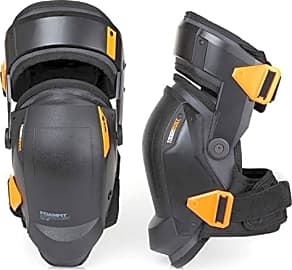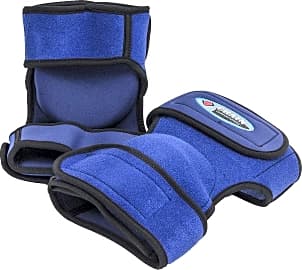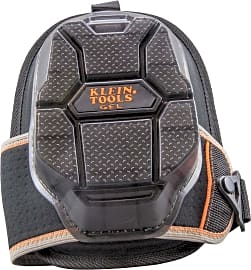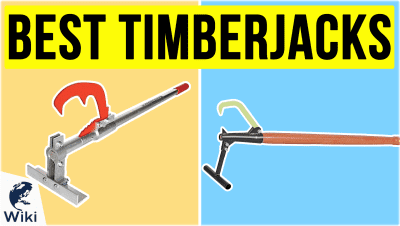The 10 Best Work Knee Pads

This wiki has been updated 39 times since it was first published in August of 2015. If you’re a plumber, electrician, flooring contractor, construction worker or avid gardener — or really anyone who spends extended time working on their hands and knees — it’s essential to protect your joints and ligaments from repetitive strain and pressure. Take a look at our selection of work knee pads to find a pair that will help keep you comfortable, healthy and productive. When users buy our independently chosen editorial choices, we may earn commissions to help fund the Wiki.
Editor's Notes
May 06, 2021:
We removed a couple selections with outdated designs that weren't very comfortable, as well as one that was highly similar to our favorite light-duty pick, the Troxell USA Leatherhead. Now leading the pack are the DeWalt DG5204, which offer the durability you'd expect from their renowned manufacturer. Also new are the Custom Leathercraft Ultraflex, which come in foam and gel varieties and are about as lightweight as they come. The final addition is the ToughBuilt KP-3, which encourage stability and are possibly the most ergonomically sound option on the list. We also really like the KP Industries Ultra Flex because of their similarly stable support, as well as their complete coverage of the knee.
February 04, 2020:
Availability issues led us to remove the TSE Safety 2.0 and Gamba Tools Elite. We also pulled the DeWalt Professional from the list due to a serious lack of durability — the clips that secure the straps tend to break after light to moderate use, and the straps lose their tension quickly.
Noted that the Crain 197 are comfortable to wear with shorts, an attribute that most heavy-duty models can’t claim. While the durability and effectiveness of the new addition Klein Tools Tradesman Pro make them an attractive option, we did find that some users feel they’re a bit too bulky.
The Thunderbolt Platinum Pro appear to be a very good value for the quality. The manufacturer has added more gel to the 2020 version of the pads for extra comfort and protection.
Special Honors
Tool Experts Construction Designed by a carpet layer but suitable for all types of tradesmen, the flexible design of these pads allows the wearer to move around and change positions without having to constantly readjust the Velcro straps. Despite their thick padding, they’re not very bulky. toolexperts.com
Is Your Profession Hard On Your Knees?
And when you hear the term plumber, many of you can’t help but conjure up the image of a worker kneeling under a sink.
When you think about jobs that require a lot of kneeling, bending over, and working on all fours, a few select occupations probably come to mind. Construction workers, a title that includes carpenters, builders, and other similar tradesmen, find themselves in these situations with regularity — so much so that construction knee pads can be considered in a category of their own. Auto mechanics spend vast amounts of time on their hands and knees working underneath cars and trucks. And when you hear the term plumber, many of you can’t help but conjure up the image of a worker kneeling under a sink.
Even if you don’t make a living in one of these vocations, that doesn't mean your line of work won’t cause knee-related problems. Professional cleaners and maids who wash floors, clean cabinets, and scrub toilets frequently put sustained pressure on their knees. The same goes for people who install carpet, tile, and other types of flooring. If you think those professions are tough on your joints, imagine the hard surfaces that bricklayers and masonry workers kneel on all day. Just thinking about it can cause discomfort.
The list goes on: electricians, roofers, miners, railroad employees, landscapers, and professional gardeners. Many athletes and dancers, both professional and amateur, put enormous strain on their knees. Even preachers, as peculiar as that sounds, face the possibility of harming their knees if they’re not careful. After all, they kneel at the altar multiple times per day, not just on Sundays and select holidays.
Though some of these careers pose more risk than others, work knee pads serve a similar purpose for each one: to protect the meniscus and the patella, or the thin layer of cartilage and tissue known as the kneecap. They are designed to absorb impact, prevent injuries, preserve your range of motion, and enhance the longevity of your knees.
Knee-related workplace injuries cause thousands of professionals to miss work each year. If you work in one of these areas, it’s not really a question of whether or not you should wear knee pads; it’s a question of which knee pads you should wear.
Prevent Pain With The Right Knee Pads
When assessing knee pads, you should begin with the most critical aspect: its cap. Hard cap knee pads minimize sharp impacts and allow you to slide and swivel around as you install carpeting, scrub the floor, or perform landscaping duties on the grass. That being said, they may cause you to slide around too much on some surfaces, like tile or slick wood, so make sure to keep that in mind.
On the other hand, if you do often find yourself kneeling in a stationery position for an extended period of time, flat-cap knee pads may be your answer.
Soft cap knee pads — which typically feature a rubber cap that allows for easy side-to-side motions — provide comfort by evenly distributing pressure. While they offer less reliable protection from harsh impacts and tough surfaces, they don’t feel as bulky and awkward as hard caps. They’re lighter, more versatile, and are usually designed with gel or foam pads. If you spend a lot of time moving around on the ground rather than kneeling in a stationery position, these should be a good fit.
On the other hand, if you do often find yourself kneeling in a stationery position for an extended period of time, flat-cap knee pads may be your answer. They are constructed with a flat structure, which creates a stable base that helps prevent you from rocking. If they’re well-designed, they should also offer reliable grip and considerable padding for plumbers, electricians, miners, and other workers who spend time working in tight, confined spaces with minimal wiggle room.
Comfort and injury prevention aren’t the only factors that drive knee pad use. Some models also serve as performance boosters. Particularly among the tradesmen and laborers mentioned above, certain knee pads can enhance productivity by providing the user more flexibility and reducing the need for frequent rest periods to ease discomfort. They can also help military personnel perform tasks like jumping, diving, and rolling with more confidence and agility.
Work At Your Own Risk: Common Injuries And Ailments
Two Texans invented the knee pad at the end of the 19th century for agricultural use in picking cotton, berries, and other crops. Though our medical knowledge has certainly progressed exponentially since then, those early knee pad users were protecting themselves from the same issues and conditions that often plague today’s laborers.
Not only is the knee the largest joint in the body, it's one of the easiest to injure. Three major bones, several tendons and ligaments, articular cartilage, and your meniscus combine to form the joint. It’s remarkably complex, and it also provides plenty of opportunities for things to go wrong.
Repetitive stress on your knee causes the ailment, which results in irritation and inflammation of one or more tendons.
One of the most common injuries to those who work in the physical trades is knee bursitis, which features swelling, inflammation, and warmth around the kneecap. The bursae, which are small sacs of fluid that reduce friction around the outside of your knee joint, become inflamed, causing pain and creating the potential for infection. Carpet layers, plumbers, and gardeners are all at significant risk, as they spend a lot of time kneeling on hard surfaces.
Though less common, patellar tendinitis can be an issue as well. Repetitive stress on your knee causes the ailment, which results in irritation and inflammation of one or more tendons. If you suffer from patellar tendinitis, kneeling down or standing up from a squatting position can be particularly painful, limiting your effectiveness at work and making life in general more difficult. For extra knee support outside of the workplace, a knee brace can help alleviate pain and make everyday tasks easier.
Why risk these injuries — and more severe ones like fractures, a dislocated kneecap or a torn tendon — when work knee caps are so readily available? If you consider the options, it’s simple: when you work on your knees, you should make sure to properly protect them.















